As sales leaders barrel into what will likely be a challenging Q4, many do not like the look of their forecasts.
Even before the rumblings of a recession, just 43% of reps in B2B tech sales were hitting their quota. Now, due to inflation, layoffs, spending and hiring freezes, and a host of other difficulties, most sales leaders agree that deal risks are popping up at the eleventh hour.
Competitors are coming out with aggressive offers that bring down market rates, and champions are under fire to make even better business cases than before. Even then, good deals do not close.
This leaves most sales and operations leaders scratching their heads after weekly forecasting meetings where it can feel as if very little progress is being made. With so much tough news, what can sales leaders do about this all? In this blog post, we’ll share our secret sauce for measuring sales productivity so you can do the same at your organization.
- How Mindtickle measures sales productivity
- The problem with how sales organizations measure sales productivity today
- How Mindtickle tracks sales productivity KPIs
- 5 scientific tips for measuring sales productivity
Focus on what you can control: sales productivity
Myopically focusing on what number will be hit or not has never helped sales leaders hit quota. Often, numbers are settled well before you enter the quarter. In this economy, even deals that previously looked highly winnable may be lost.
Focusing on leading indicators, such as sales productivity, provides a better way to understand how ready your organization is to sell, and how rapidly your team is improving. In this blog, we’ll share five ways you can scientifically measure sales productivity and forecast with much higher accuracy than before.
How Mindtickle measures sales productivity
At Mindtickle, we define sales productivity as how efficient and effective your sales executives are at hitting a variety of revenue milestones and goals. Of course, just because reps are making more calls and sending more emails does not mean they are necessarily progressing sales or generating revenue.
That’s why, in addition to accountability around activity tracking, measuring preparation and effectiveness is key.
Here, we use our Sales Readiness Index to measure which reps are demonstrating the right skills, will, and in-field behaviors. With our readiness index, we cross-reference who is hitting quota with who is doing all of the other activities that make a rep successful, such as:
- Conducting effective outreach
- Engaging buyers
- Sending educational content
- Completing new product and competitor training
- Practicing via AI video role-plays
- Achieving high call scores
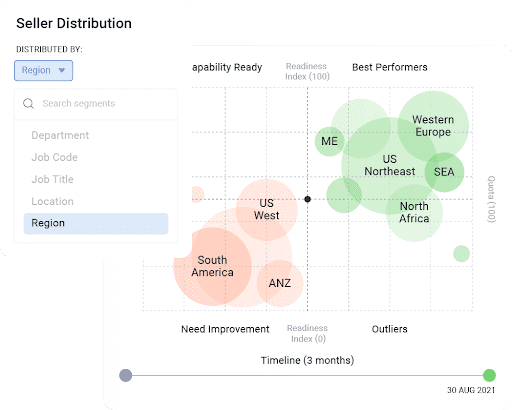
At the same time, we use revenue intelligence and AI forecasting software through our technical partner BoostUp to help our sellers call their numbers with higher accuracy and confidence.
Deal risk analytics give detailed signals that help reps know exactly what action they need to take when they follow up, such as better multi-threading with a higher number of senior-level contacts.
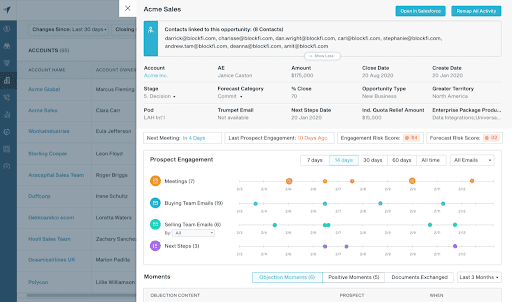

At the same time, our sales enablement function moved from a traditional approach where most time was spent creating content, and delivering trainings, to focusing on call and deal reviews. We call this revenue enablement and have rallied our entire organization around the concept of ensuring sellers focus on closing more deals with confidence.
The problem with how sales organizations measure sales productivity today
Many organizations use Salesforce to track revenue metrics and sales productivity. Yet not long ago, sales professionals started to game the system to hit their numbers. Maybe they exaggerated prospecting or sandbagged their forecast so they could sweep in as the hero at the end of the quarter, or got overly optimistic about pricing and happy ears.
Here at Mindtickle, our revenue intelligence and forecasting solution is built in to our readiness platform so our sales managers use a new workflow to gain a deeper level of transparency into deals, calls, and buyer engagement.
You can see that workflow in our interactive sales manager product tour here.
Instead of looking at lagging indicators of success, such as who has the most pipeline or who has historically hit their numbers, we look at what our reps do holistically to prepare for the future climate. We better understand where our reps are putting their time and calories, and have put accountability systems in place to help them uncover risks, and focus on truly winnable deals.
This means our executives have real-time visibility into every call, email, and meeting, and they spend more time helping reps uncover deal blockers so they not only forecast more accurately, but help reps deliver faster, better wins.
How Mindtickle tracks sales productivity KPIs
Sales productivity can be tracked many ways. Here are some of the metrics we use to keep our team on track.
- Deal health scores: With our revenue intelligence solution, every deal is scored and labeled red, yellow, or green so reps know exactly why a deal is at risk, and how to address it.
- Call scores: With our Call AI solution, we score every call against the winning behaviors from top reps on every team, including BDRs, account executives, sales engineers, and customer success executives
- Email sends & dials to conversions: We look at not only how many emails and dials our reps make, but also what percent of those connected touchpoints convert. This helps us understand quantity and quality.
- # of meetings that take place: We look at the number of meetings that are scheduled, and examine those that were actually completed and deemed sales-qualified or not by our reps.
- Buyer engagement and sentiment: By analyzing all of the calls, emails, and meetings that take place, we are able to uncover keywords associate with deal risks, or positive/negative buyer sentiment. Increasingly, buyer engagement and sentiment is a really important metric for us as we look to forecast more accurately and truly assess deal health.
- Content usage & engagement: Our sales content management solution tracks metrics beyond just asset views and also looks at content adoption. This includes the number of times each asset has been used in the sales process, the percentage of sellers who have used each asset, and the number of times each asset has been shared in deals progressing in stages including closed/won.
- Sales enablement program data: This includes onboarding and ramp-up metrics for new hires like time to onboarding completion, time to first deal/revenue, average ramp time, annual number of new hires, and yearly rep attrition. We also look at everboarding or ongoing readiness metrics like seconds of training videos watched, pages of documents read, correct answers on assessments and questions asked over time, scores on video role-plays, overall team performance on programs, certification completions, rep feedback on program efficacy, and overall engagement.
- Pipeline and forecasting data: We look at whether reps, teams, and regions have enough pipeline coverage to hit their number
5 scientific tips for measuring sales productivity
So how do we measure all of this vast data and make sense of it all without creating a ton of work for our operations team in charge of measuring sales productivity and forecasting?
1. End manual data entry
The days of relying on manually entered Salesforce data and trusting it’s correct are long dead. We implemented revenue intelligence and forecasting through our BoostUp integration to track the activities that meaningfully move deals forward (or stall them).
To do this, we started by tracking buyer engagement across every call, email and meeting – all of which we transcribe and tag when we uncover an important voice of customer insight, such as a competitor or product mention, next step, or strong instance of buyer hesitation.
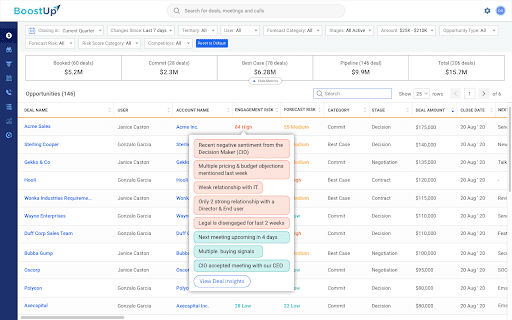

We use this information to score every deal and proactively uncover risks. At the same time, we improved the way we do opportunity management by pulling together a rich visualization of all of the activity that has taken place – including what emails buyers and sellers have sent, what calls have taken place, what meaningful sales themes have been mentioned, and even whether or not our sellers have created a Digital Sales Room to engage customers with educational content.
This helps us offer self-coaching to reps by nudging them with activities we know will move a deal forward, such as follow-up content they might want to send, or battle cards they should review before their next call.
Our enterprise team takes more of an account-based approach. We track the number and percentage of accounts in each rep’s territory that haven’t seen an activity logged in the last 30 days.
To ensure both our enterprise and commercial teams multi-thread, we track how many personas are engaged in an opportunity, and if we’ve reached the VP+ level.
Content analytics are also important to us. This year, we launched our Digital Sales Rooms – a digital buyer experience helping reps share content, understand what content customers and prospects are engaging with, link to call recordings, and manage the next steps.
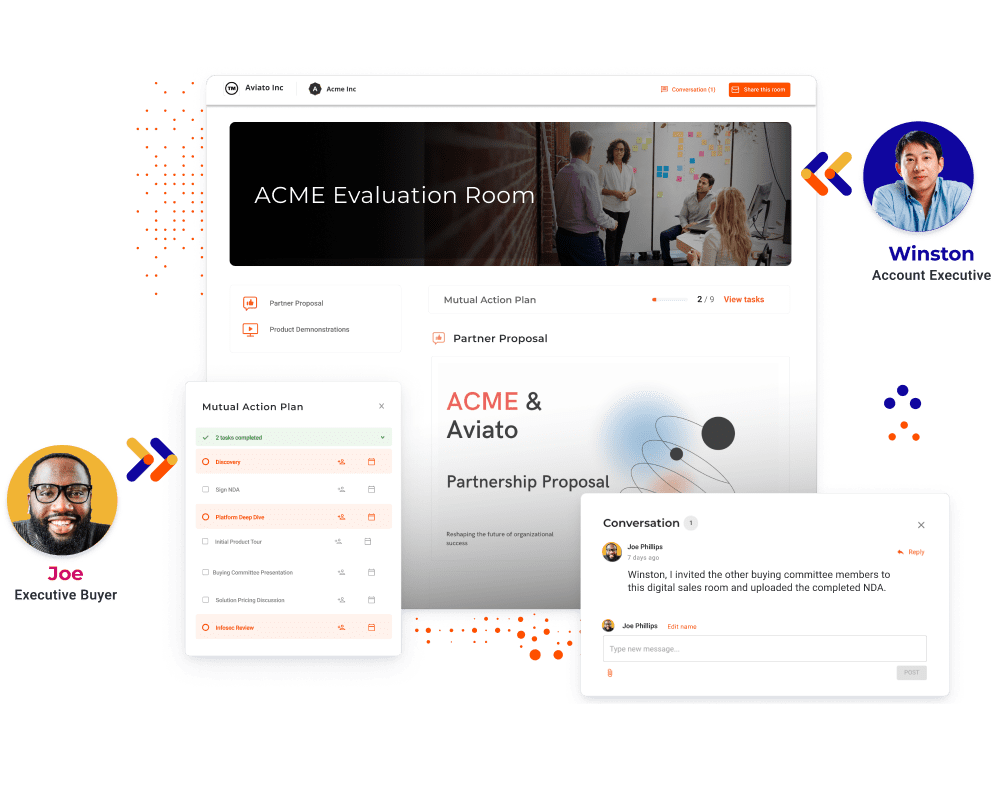

Digital sales rooms have helped our sellers better multi-thread and improve engagement with our content by 300%.
2. Cut meetings in half, and reserve more time for practice & coaching
One invaluable tool for sales productivity is Call AI – our conversation intelligence technology that records, transcribes, and analyzes every call while making calls easily shareable with other departments, such as product or marketing.
Now that our sellers can listen to calls on 2X that they weren’t a part of, and don’t have to spend time on internal updates calls and hand-offs. This makes it faster and easier for every relevant person here at Mindtickle, such as our CSMs, to get the deep details on every deal or account while attending fewer, but more valuable meetings.
Where did we reinvest those hours of precious extra time each week?
Into practicing via AI video role-plays, and data-driven call coaching.
Here are some examples of how our sellers self-coach and get automatic feedback on how they handle difficult questions and objections.
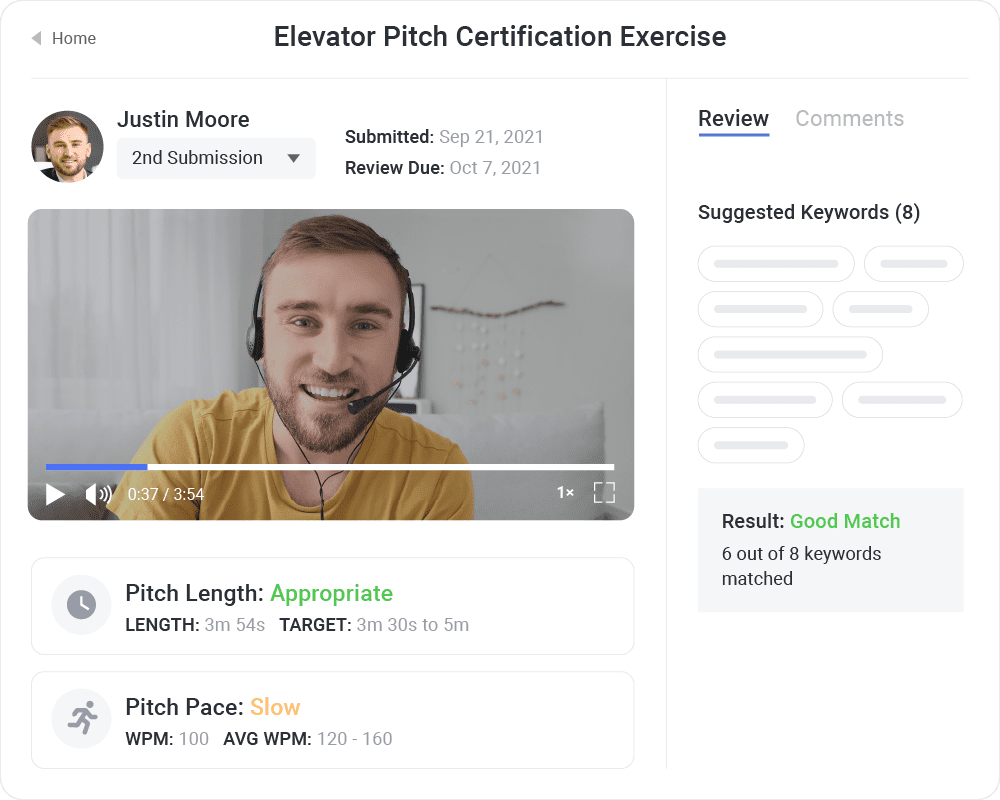

Here’s how our reps use call score analytics to understand their talk time, whether they’re using filler words, understanding how many questions they’re really asking, and digging into the customer’s longest monologue – e.g. the moment where the customer truly opened up.
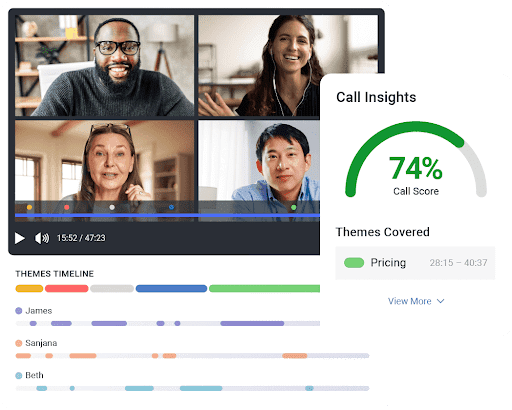

3. Create better buyer experiences
Sales productivity has never been about drowning customers in emails and cold calls. It’s been about connecting with the right person, at the right time, with meaningful information that helps them solve significant business challenges.
That’s why we started using Databook to provide our sales reps with better information on how their accounts are doing financially and their “big bets.” This enables reps to provide hyper-personalized outreach and follow-ups.
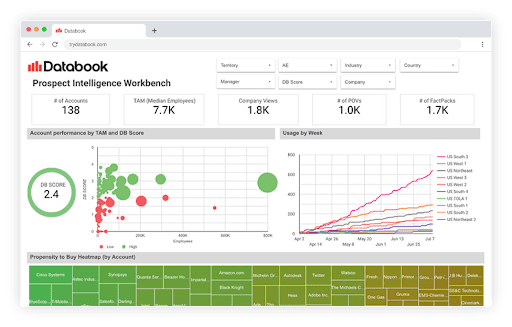

At the same time, we regularly share call recordings with our customers so that they can include others who may have missed a meeting without slowing the sales cycle down.
4. Leverage AI for more accurate pipeline & sales forecasting
Earlier in this blog, we talked about how sales productivity is a better leading indicator to drive scalable, repeatable sales and to enable fact-based forecasting.
Perhaps no group in our organization is better at reaping the rewards of the newfound focus we’ve put on sales productivity than our operations organization.
Whereas before reps and regional vice presidents would manually call their number, we now use revenue intelligence and forecasting software to analyze that number and how realistic it is with AI. Then, we go a step further by uncovering pipeline trends and risks that may prevent us from hitting it.
We are also able to look at week-over-week and month-over-month waterfall charts to analyze where our pipeline is growing and decreasing so that we can better address issues with enablement programs.
This saves our revenue operations more than 30 hours of time previously spent on manual reporting a week.
5. Consolidate redundant sales technologies
In this economic moment, it’s not uncommon for sales teams to be asked to reduce their sales technology budgets by 30-50%, or even more. That’s a lofty challenge, but it’s also a painful reminder that too many teams are using bloated, expensive sales tech stacks that aren’t actually helping improve their ability to hit their number.
Our 2022-2023 Sales Enablement Outlook found that about a third (32%) of respondents indicate there are 10 or more tools to support their tech stack. Notably, 51% of sales leadership professionals indicate this is the case.
However, investing in a sales tool doesn’t necessarily mean it’ll be used by the sales team. Twenty-eight percent of respondents report their teams use 10 or more tools on a daily basis. And 53% use five or more.
Here are some solutions we use at Mindtickle:
- Our platform, through which we run enablement, manage content and operate all of our conversation intelligence, revenue intelligence, and forecasting solutions, including enabling our reps to update Salesforce
- Outreach.IO for BDR prospecting
- Databook to uncover personalized account-based insights
- LinkedIn Navigator & ZoomInfo to find prospects and contacts across our accounts
If you’re interested to learn more about our best practices and how to consolidate your sales tech stack while driving more revenue per rep, reach out to request a demo here.
For further reading, check out some of our top resources:








